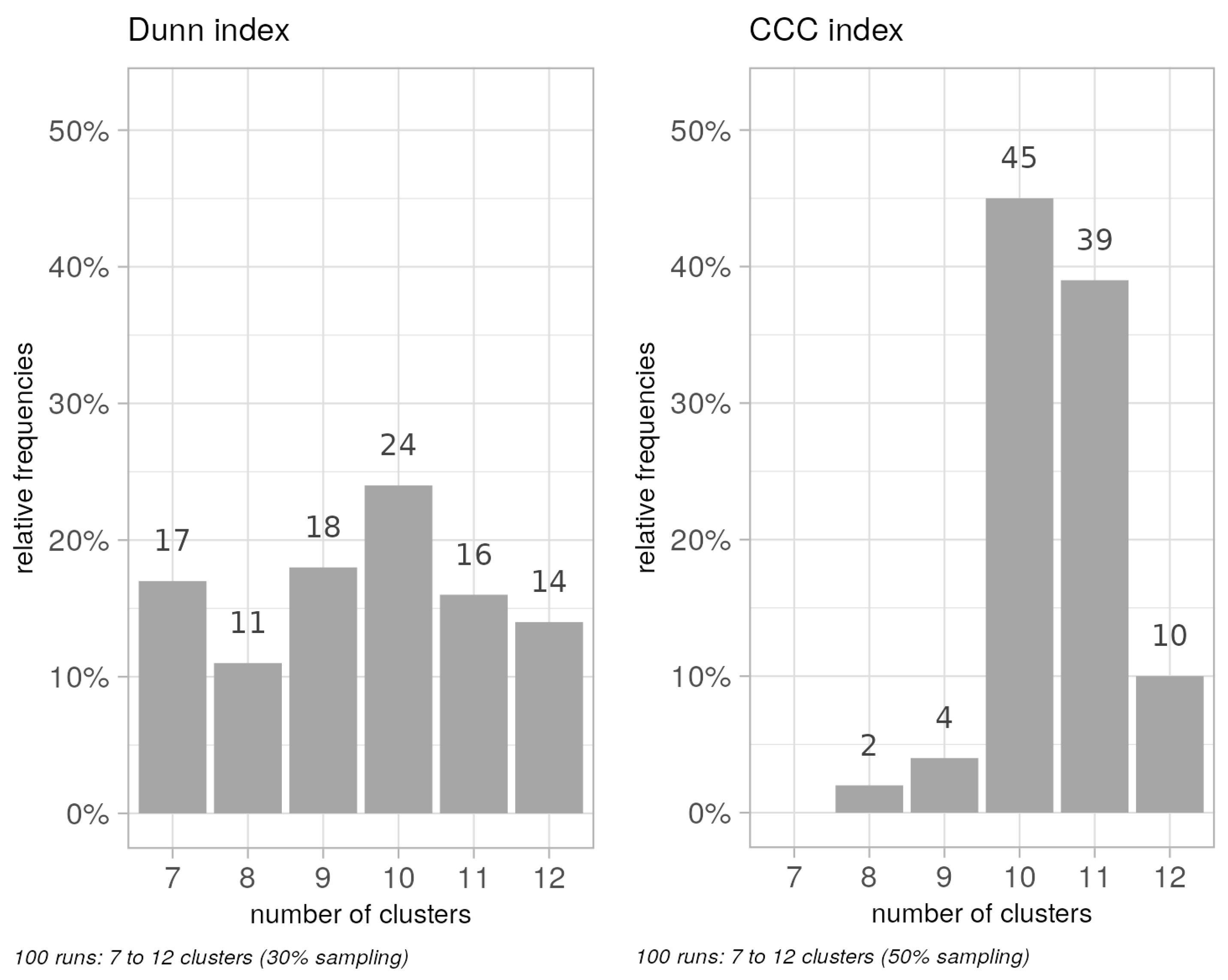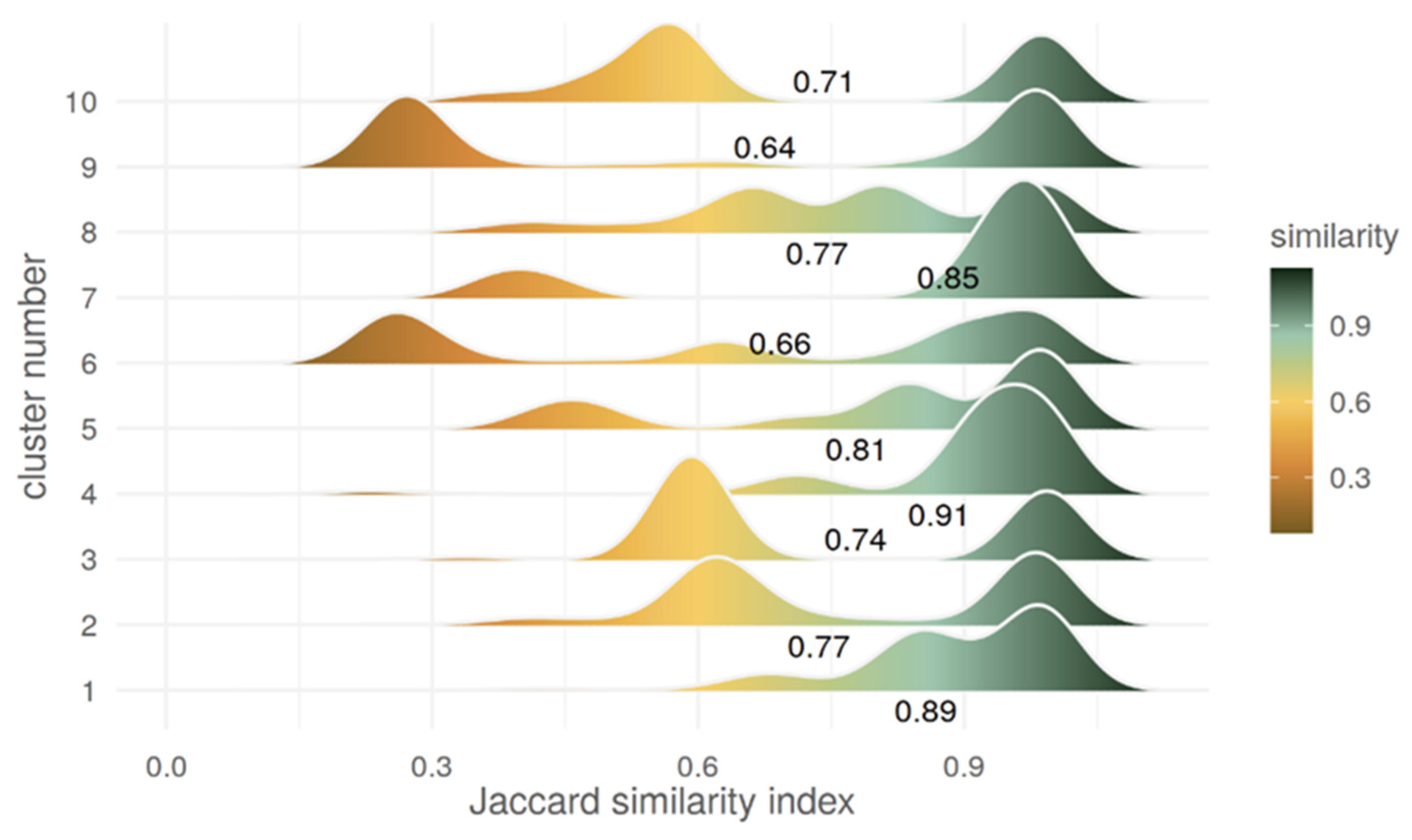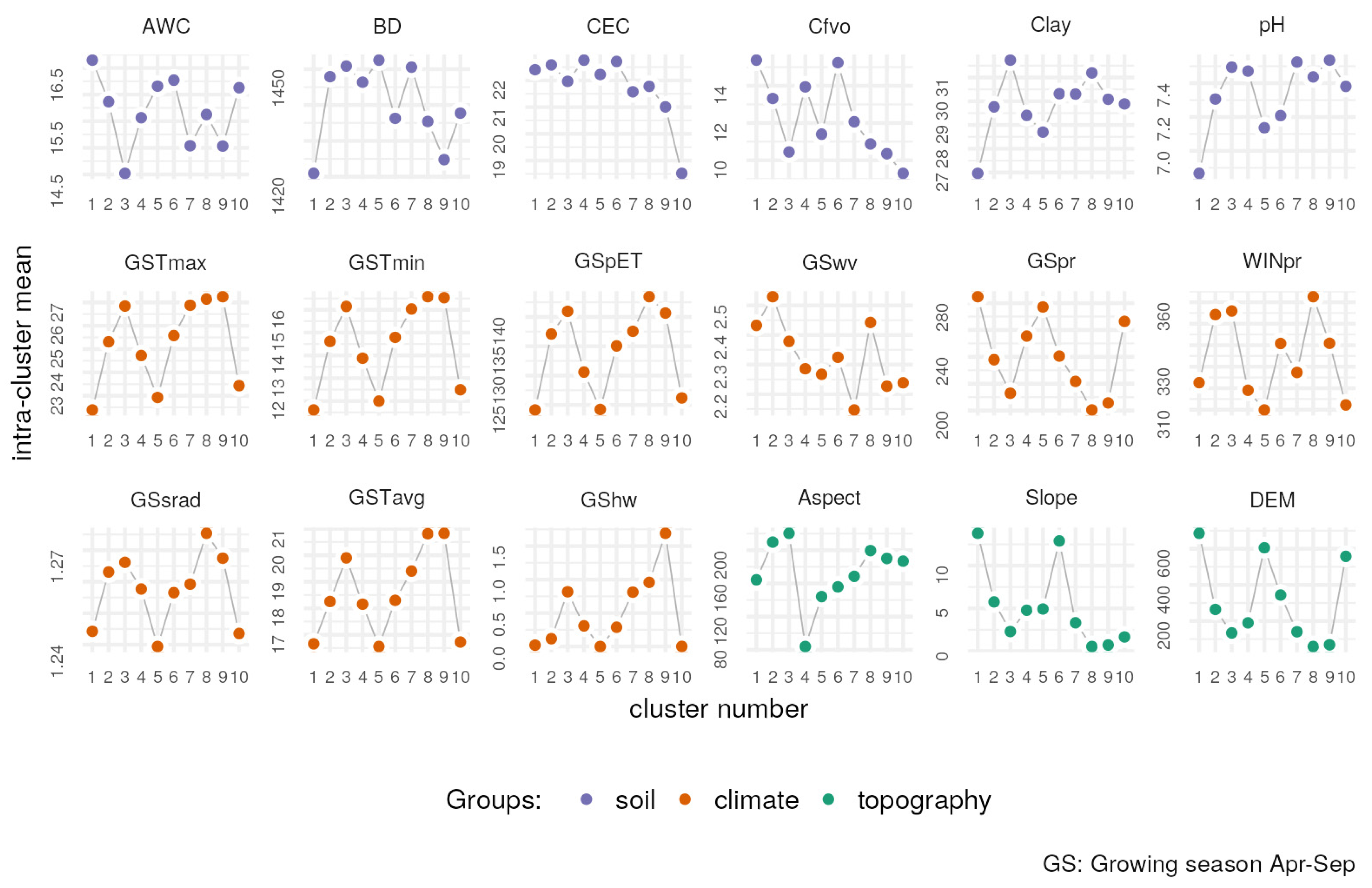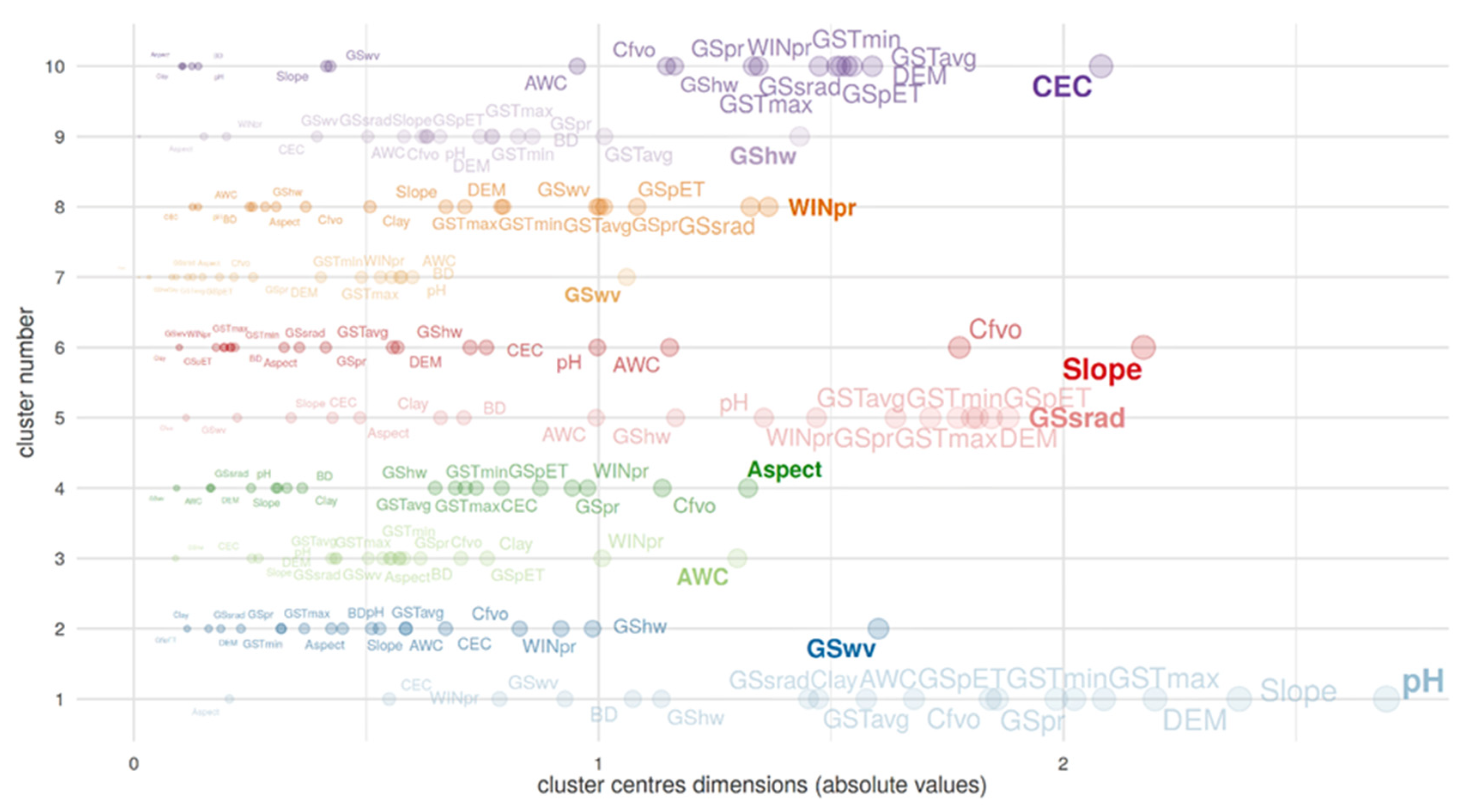Delineating Natural Terroir Units in Wine Regions Using Geoinformatics
Abstract
:1. Introduction
2. Materials and Methods
2.1. Study Area
2.2. Data Sources
- Copernicus Land Monitoring Service (ver.3). Land Cover Change Version 3.0 product at 100 m resolution. The Copernicus Global Land Service (CGLS) systematically produces a series of qualified bio-geophysical products on a regular basis, at a global scale and at mid to low spatial resolution (https://land.copernicus.eu/global/products/lc, accessed on 30 November 2022). Land cover from CGLS was used for the purpose of masking the area of interest to the agricultural land cover class;
- Copernicus Sentinel-2 MSI Data supporting the monitoring of vegetation from the online GEE platform (https://developers.google.com/earth-engine/datasets/catalog/COPERNICUS_S2_SR_HARMONIZED#description, accessed on 30 November 2022);
- European Digital Elevation Model (EU-DEM), version 1.1. The EU-DEM v1.1 is a contiguous dataset, distributed and divided into 1000 km × 1000 km tiles, at 25 m resolution, in geotiff 32-bit format (https://land.copernicus.eu/imagery-in-situ/eu-dem/, accessed on 30 November 2022);
- SoilGrids. SoilGrids is a system for digital soil mapping service based on a global compilation of soil profile data (WoSIS) and environmental layers [22]. SoilGrids delivers global predictions at 250 m resolution for standard numeric soil properties at seven standard depths, in addition to the distribution of soil classes distribution, based on the World Reference Base (WRB) and USDA classification systems (https://data.isric.org/geonetwork/srv/eng/catalog.search, accessed on 30 November 2022);
- EU-SoilHydroGrids ver. 1.0. EU-SoilHydroGrids ver1.0 provides soil hydrological data with full continental coverage. The multilayered European Soil Hydraulic Database (EU-SoilHydroGrids ver1.0) was derived via European pedotransfer functions (EU-PTFs) based on the soil information of SoilGrids250 m and aggregated 1 km resolution datasets (https://esdac.jrc.ec.europa.eu/content/3d-soil, accessed on 30 November 2022) [22,23];
- Climate Data Store. European Centre for Medium-Range Weather Forecasts (ECMWF) is producing an enhanced global dataset concerning the land component of the fifth generation of European Re-Analysis (ERA5), referred to as ERA5-Land. Climatic data concerning temperature, precipitation, evapotranspiration, wind speed, and incoming solar radiation were accessed in the form of time-series averages for the time period of 2002–2022, extracted from monthly averaged data for all climatic variables besides heat frequency, which resulted from hourly analysis data. (https://cds.climate.copernicus.eu/cdsapp, accessed on 30 November 2022).
2.3. Cluster Analysis
2.3.1. K-means Clustering
2.3.2. Optimal Number of Clusters
2.3.3. Cluster Validation
3. Results
3.1. Cluster Stability
3.2. NTUs Distribution and Characterization
3.3. External Validation
3.4. Implications of NTUs in Vini-Viticulture
3.5. Advantages and Limitations of the Proposed Methodology
4. Conclusions
Author Contributions
Funding
Institutional Review Board Statement
Data Availability Statement
Conflicts of Interest
References
- Carey, V.A. Spatial Characterisation of Natural Terroir Units for Viticulture in the Bottelaryberg-Simonsberg-Helderberg Winegrowing Area; Stellenbosch University: Stellenbosch, South Africa, 2001. [Google Scholar]
- Bodin, F.; Morlat, R. Characterization of viticultural terroirs using a simple field model based on soil depth I. Validation of the water supply regime, phenology and vine vigour, in the Anjou vineyard (France). Plant Soil 2006, 281, 37–54. [Google Scholar] [CrossRef]
- Tesic, D.; Woolley, D.J.; Hewett, E.W.; Martin, D.J. Environmental effects on cv. Cabernet Sauvignon (Vitis vinifera L.) grown in Hawke’s Bay, New Zealand.: 1. Phenology and characterisation of viticultural environments. Aust. J. Grape Wine Res. 2002, 8, 15–26. [Google Scholar] [CrossRef]
- Van Leeuwen, C.; Friant, P.; Choné, X.; Tregoat, O.; Koundouras, S.; Dubourdieu, D. Influence of Climate, Soil, and Cultivar on Terroir. Am. J. Enol. Vitic. 2004, 55, 207–217. [Google Scholar] [CrossRef]
- Priori, S.; Barbetti, R.; L’Abate, G.; Bucelli, P.; Storchi, P.; Costantini, E.A. Natural terroir units, Siena province, Tuscany. J. Map. 2014, 10, 466–477. [Google Scholar] [CrossRef] [Green Version]
- Bramley, R.G.; Ouzman, J.; Trought, M.C. Making sense of a sense of place: Precision viticulture approaches to the analysis of terroir at different scales. OENO One 2020, 54, 903–917. [Google Scholar] [CrossRef]
- Vaudour, E.; Costantini, E.; Jones, G.V.; Mocali, S. An overview of the recent approaches to terroir functional modelling, footprinting and zoning. Soil 2015, 1, 287–312. [Google Scholar] [CrossRef] [Green Version]
- Mackenzie, D.; Christy, A. The role of soil chemistry in wine grape quality and sustainable soil management in vineyards. Water Sci. Technol. 2005, 51, 27–37. [Google Scholar] [CrossRef] [PubMed]
- Fraga, H.; Malheiro, A.C.; Moutinho-Pereira, J.; Cardoso, R.M.; Soares, P.M.; Cancela, J.J.; Pinto, J.G.; Santos, J.A. Integrated analysis of climate, soil, topography and vegetative growth in Iberian viticultural regions. PLoS ONE 2014, 9, e108078. [Google Scholar] [CrossRef]
- Flexas, J.; Galmés, J.; Gallé, A.; Gulías, J.; Pou, A.; Ribas-Carbo, M.; Tomàs, M.; Medrano, H. Improving water use efficiency in grapevines: Potential physiological targets for biotechnological improvement. Aust. J. Grape Wine Res. 2010, 16, 106–121. [Google Scholar] [CrossRef]
- Jones, G.; Snead, N.; Nelson, P. Geology and wine 8. Modeling viticultural landscapes: A GIS analysis of the terroir potential in the Umpqua Valley of Oregon. Geosci. Can. 2004, 31, 167–178. [Google Scholar]
- Jones, G.V.; Davis, R.E. Climate influences on grapevine phenology, grape composition, and wine production and quality for Bordeaux, France. Am. J. Enol. Vitic. 2000, 51, 249–261. [Google Scholar] [CrossRef]
- Santos, J.A.; Malheiro, A.C.; Karremann, M.K.; Pinto, J.G. Statistical modelling of grapevine yield in the Port Wine region under present and future climate conditions. Int. J. Biometeorol. 2011, 55, 119–131. [Google Scholar] [CrossRef]
- Jones, G.V. Climate and terroir: Impacts of climate variability and change on wine. Geosci. Can. Repr. Ser. 2006, 9, 203–217. [Google Scholar]
- Zsófi, Z.; Tóth, E.; Rusjan, D.; Bálo, B. Terroir aspects of grape quality in a cool climate wine region: Relationship between water deficit, vegetative growth and berry sugar concentration. Sci. Hortic. 2011, 127, 494–499. [Google Scholar] [CrossRef]
- Van Leeuwen, C.; Barbe, J.-C.; Darriet, P.; Geffroy, O.; Gomès, E.; Guillaumie, S.; Helwi, P.; Laboyrie, J.; Lytra, G.; Le Menn, N.; et al. Recent advancements in understanding the terroir effect on aromas in grapes and wines. OENO One 2020, 54, 985–1006. [Google Scholar] [CrossRef]
- Costantini, E.A.C.; Bucelli, P. Soil and terroir. In Soil Security for Ecosystem Management; Springer International Publishing: Cham, Switzerland, 2014; pp. 97–133. [Google Scholar]
- Vaudour, E. The Quality of Grapes and Wine in Relation to Geography: Notions of Terroir at Various Scales. J. Wine Res. 2002, 13, 117–141. [Google Scholar] [CrossRef]
- Lagacherie, P.; Bailly, J.-S.; Monestiez, P.; Gomez, C. Using scattered hyperspectral imagery data to map the soil properties of a region. Eur. J. Soil Sci. 2012, 63, 110–119. [Google Scholar] [CrossRef] [Green Version]
- Morari, F.; Castrignanò, A.; Pagliarin, C. Application of multivariate geostatistics in delineating management zones within a gravelly vineyard using geo-electrical sensors. Comput. Electron. Agric. 2009, 68, 97–107. [Google Scholar] [CrossRef]
- Castrignanò, A.; Costantini, E.A.; Barbetti, R.; Sollitto, D. Accounting for extensive topographic and pedologic secondary information to improve soil mapping. Catena 2009, 77, 28–38. [Google Scholar] [CrossRef]
- Hengl, T.; Mendes de Jesus, J.; Heuvelink, G.B.; Ruiperez Gonzalez, M.; Kilibarda, M.; Blagotić, A.; Shangguan, W.; Wright, M.N.; Geng, X.; Bauer-Marschallinger, B. SoilGrids250m: Global gridded soil information based on machine learning. PLoS ONE 2017, 12, e0169748. [Google Scholar] [CrossRef] [PubMed] [Green Version]
- Tóth, B.; Weynants, M.; Pásztor, L.; Hengl, T. 3D soil hydraulic database of Europe at 250 m resolution. Hydrol. Process. 2017, 31, 2662–2666. [Google Scholar] [CrossRef] [Green Version]
- Hartigan, J.A.; Wong, M.A. Algorithm AS 136: A k-means clustering algorithm. J. R. Stat. Soc. Ser. C 1979, 28, 100–108. [Google Scholar] [CrossRef]
- Morissette, L.; Chartier, S. The k-means clustering technique: General considerations and implementation in Mathematica. Tutor. Quant Methods Psychol. 2013, 9, 15–24. [Google Scholar] [CrossRef] [Green Version]
- Fränti, P.; Sieranoja, S. How much can k-means be improved by using better initialization and repeats? Pattern Recognit. 2019, 93, 95–112. [Google Scholar] [CrossRef]
- Jain, A.K. Data clustering: 50 years beyond K-means. Pattern Recog. Lett. 2010, 31, 651–666. [Google Scholar] [CrossRef]
- Äyrämö, S.; Kärkkäinen, T. Introduction to partitioning-based clustering methods with a robust example. In Reports of the Department of Mathematical Information Technology. Series C, Software Engineering and Computational Intelligence; National Library of Finland: Helsinki, Finland, 2006. [Google Scholar]
- Dunn, J.C. Well-separated clusters and optimal fuzzy partitions. J. Cybern. 1974, 4, 95–104. [Google Scholar] [CrossRef]
- Sarle, W.S. SAS Technical Report A-108, Cubic Clustering Criterion; SAS Institute Inc: Cary, NC, USA, 1983; p. 56. [Google Scholar]
- Brun, M.; Sima, C.; Hua, J.; Lowey, J.; Carroll, B.; Suh, E.; Dougherty, E.R. Model-based evaluation of clustering validation measures. Pattern Recognit. 2007, 40, 807–824. [Google Scholar] [CrossRef]
- Hennig, C. Cluster-wise assessment of cluster stability. Comput. Stat. Data Anal. 2007, 52, 258–271. [Google Scholar] [CrossRef] [Green Version]
- Santesteban, L.; Guillaume, S.; Royo, J.; Tisseyre, B. Are precision agriculture tools and methods relevant at the whole-vineyard scale? Precis. Agric. 2013, 14, 2–17. [Google Scholar] [CrossRef] [Green Version]
- Fiorillo, E.; Crisci, A.; De Filippis, T.; Di Gennaro, S.; Di Blasi, S.; Matese, A.; Primicerio, J.; Vaccari, F.; Genesio, L. Airborne high-resolution images for grape classification: Changes in correlation between technological and late maturity in a Sangiovese vineyard in Central Italy. Aust. J. Grape Wine Res. 2012, 18, 80–90. [Google Scholar] [CrossRef]
- Lamb, D.W.; Weedon, M.; Bramley, R. Using remote sensing to predict grape phenolics and colour at harvest in a Cabernet Sauvignon vineyard: Timing observations against vine phenology and optimising image resolution. Aust. J. Grape Wine Res. 2004, 10, 46–54. [Google Scholar] [CrossRef] [Green Version]
- Charrad, M.; Ghazzali, N.; Boiteau, V.; Niknafs, A. NbClust: An R package for determining the relevant number of clusters in a data set. J. Stat. Softw. 2014, 61, 1–36. [Google Scholar] [CrossRef] [Green Version]
- Team, R.C. R: A Language and Environment for Statistical Computing; R Foundation for Statistical Computing: Vienna, Austria. Available online: http://www.R-project.org/ (accessed on 5 January 2023).
- Hennig, C. ‘fpc: Flexible Procedures for Clustering’, R-Package Version 2.2-9. Available online: https://cran.r-project.org/web/packages/fpc/ (accessed on 30 November 2022).
- Levene, H. Robust tests for equality of variances. In Contributions to Probability and Statistics: Essays in Honor of Harold Hotelling; Olkin, I., Hotelling, H., Eds.; Stanford University Press: Redwood City, CA, USA, 1960; pp. 278–292. [Google Scholar]
- Welch, B.L. On the comparison of several mean values: An alternative approach. Biometrika 1951, 38, 330–336. [Google Scholar] [CrossRef]
- Tiefelsdorf, M.; Griffith, D.A. Semiparametric filtering of spatial autocorrelation: The eigenvector approach. Environ. Plan. A 2007, 39, 1193–1221. [Google Scholar] [CrossRef]
- Bivand, R.; Millo, G.; Piras, G. A review of software for spatial econometrics in R. Mathematics 2021, 9, 1276. [Google Scholar] [CrossRef]
- Anastasiou, E.; Balafoutis, A.; Theocharis, S.; Theodorou, N.; Koundouras, S.; Fountas, S. Assessment of Laser Scanner Use under Different Settings in Two Differently Managed Vineyards for Estimating Pruning Wood Parameters. AgriEngineering 2022, 4, 47. [Google Scholar] [CrossRef]
- Van Leeuwen, C.; Trégoat, O.; Choné, X.; Bois, B.; Pernet, D.; Gaudillère, J.-P. Vine water status is a key factor in grape ripening and vintage quality for red Bordeaux wine. How can it be assessed for vineyard management purposes? OENO One 2009, 43, 121–134. [Google Scholar] [CrossRef]
- Allen, M.S.; Lacey, M.J.; Harris, R.L.N.; Brown, W.V. Contribution of Methoxypyrazines to Sauvignon blanc Wine Aroma. Am. J. Enol. Vitic. 1991, 42, 109–112. [Google Scholar] [CrossRef]
- Zhang, P.; Howell, K.; Krstic, M.; Herderich, M.; Barlow, E.W.; Fuentes, S. Environmental Factors and Seasonality Affect the Concentration of Rotundone in Vitis vinifera L. cv. Shiraz Wine. PLoS ONE 2015, 10, e0133137. [Google Scholar] [CrossRef] [Green Version]
- Bureau, S.M.; Baumes, R.L.; Razungles, A.J. Effects of Vine or Bunch Shading on the Glycosylated Flavor Precursors in Grapes of Vitis vinifera L. Cv. Syrah. J. Agric. Food Chem. 2000, 48, 1290–1297. [Google Scholar] [CrossRef] [PubMed]
- Marais, J. Sauvignon blanc cultivar aroma—A review. South Afr. J. Enol. Vitic. 1994, 15, 41–45. [Google Scholar] [CrossRef] [Green Version]
- Des Gachons, C.P.; Leeuwen, C.V.; Tominaga, T.; Soyer, J.-P.; Gaudillère, J.-P.; Dubourdieu, D. Influence of water and nitrogen deficit on fruit ripening and aroma potential of Vitis vinifera L cv Sauvignon blanc in field conditions. J. Sci. Food Agric. 2005, 85, 73–85. [Google Scholar] [CrossRef]
- Sala, C.; Busto, O.; Guasch, J.; Zamora, F. Contents of 3-alkyl-2-methoxypyrazines in musts and wines from Vitis vinifera variety Cabernet Sauvignon: Influence of irrigation and plantation density. J. Sci. Food Agric. 2005, 85, 1131–1136. [Google Scholar] [CrossRef]
- Koundouras, S.; Hatzidimitriou, E.; Karamolegkou, M.; Dimopoulou, E.; Kallithraka, S.; Tsialtas, J.T.; Zioziou, E.; Nikolaou, N.; Kotseridis, Y. Irrigation and Rootstock Effects on the Phenolic Concentration and Aroma Potential of Vitis vinifera L. cv. Cabernet Sauvignon Grapes. J. Agric. Food Chem. 2009, 57, 7805–7813. [Google Scholar] [CrossRef]
- Koundouras, S.; Marinos, V.; Gkoulioti, A.; Kotseridis, Y.; van Leeuwen, C. Influence of Vineyard Location and Vine Water Status on Fruit Maturation of Nonirrigated Cv. Agiorgitiko (Vitis vinifera L.). Effects on Wine Phenolic and Aroma Components. J. Agric. Food Chem. 2006, 54, 5077–5086. [Google Scholar] [CrossRef] [PubMed]
- Koufos, G.C.; Mavromatis, T.; Koundouras, S.; Fyllas, N.M.; Theocharis, S.; Jones, G.V. Greek Wine Quality Assessment and Relationships with Climate: Trends, Future Projections and Uncertainties. Water 2022, 14, 573. [Google Scholar] [CrossRef]







| No. InputVariable | Units | Min. | 1st Qu. | Median | Mean | 3rd Qu. | Max. | Std.dev | CV % | |
|---|---|---|---|---|---|---|---|---|---|---|
| 1 | Available Water Capacity | % | 13.61 | 14.92 | 15.38 | 15.45 | 15.99 | 18.69 | 0.708 | 4.586 |
| 2 | Soil bulk density | kg/cm3 | 1256 | 1428 | 1440 | 1440 | 1452 | 1502 | 17.71 | 1.23 |
| 3 | Cation Exchange Capacity | cmol/kg | 16.53 | 20.78 | 21.59 | 21.59 | 22.52 | 27.12 | 1.477 | 6.839 |
| 4 | Soil pH | - | 6.018 | 7.362 | 7.463 | 7.409 | 7.528 | 7.782 | 0.201 | 2.717 |
| 5 | Coarse fragments Vol. fraction | vol % | 6.368 | 10.22 | 11.35 | 11.63 | 12.83 | 20.21 | 2.034 | 17.48 |
| 6 | Clay Soil fraction | % | 19.69 | 28.68 | 30.11 | 30.11 | 31.53 | 41.09 | 2.136 | 7.096 |
| 7 | GS Heat frequency | % | 0 | 0.072 | 0.669 | 0.758 | 1.283 | 2.093 | 0.651 | 85.78 |
| 8 | GS Downward shortwave radiation | e08 J/m2 | 1.22 | 1.256 | 1.262 | 1.261 | 1.268 | 1.279 | 0.012 | 0.889 |
| 9 | GS Mean Temperature | °C | 14.95 | 17.93 | 19.53 | 19.2 | 20.64 | 21.27 | 1.611 | 8.395 |
| 10 | GS Max Temperature | °C | 20.12 | 24.86 | 26.84 | 25.93 | 27.2 | 27.36 | 1.7 | 6.556 |
| 11 | GS Min Temperature | °C | 9.497 | 14.07 | 16.07 | 15.17 | 16.51 | 16.69 | 1.763 | 11.62 |
| 12 | GS Reference Evapotranspiration | mm | 117.2 | 133.2 | 138.5 | 136.3 | 141.1 | 145.4 | 6.561 | 4.813 |
| 13 | GS Wind speed | m/s | 2.087 | 2.184 | 2.273 | 2.299 | 2.4 | 3.051 | 0.143 | 6.229 |
| 14 | GS Precipitation | mm | 196.7 | 205.6 | 219 | 229 | 250.7 | 315.9 | 28.15 | 12.29 |
| 15 | Winter Season Precipitation | mm | 304.3 | 320.8 | 338.4 | 337.1 | 353.7 | 378.1 | 18.54 | 5.499 |
| 16 | Digital Elevation Model | m | 41.7 | 72.59 | 129.3 | 225.3 | 297.2 | 1307 | 210.1 | 93.28 |
| 17 | Terrain Aspect | deg. | 0.051 | 133.9 | 185 | 179.1 | 222.5 | 360 | 72.02 | 40.22 |
| 18 | Terrain Slope | % | 0.002 | 0.627 | 1.831 | 3.465 | 4.712 | 42.53 | 4.347 | 125.5 |
Disclaimer/Publisher’s Note: The statements, opinions and data contained in all publications are solely those of the individual author(s) and contributor(s) and not of MDPI and/or the editor(s). MDPI and/or the editor(s) disclaim responsibility for any injury to people or property resulting from any ideas, methods, instructions or products referred to in the content. |
© 2023 by the authors. Licensee MDPI, Basel, Switzerland. This article is an open access article distributed under the terms and conditions of the Creative Commons Attribution (CC BY) license (https://creativecommons.org/licenses/by/4.0/).
Share and Cite
Karapetsas, N.; Alexandridis, T.K.; Bilas, G.; Theocharis, S.; Koundouras, S. Delineating Natural Terroir Units in Wine Regions Using Geoinformatics. Agriculture 2023, 13, 629. https://doi.org/10.3390/agriculture13030629
Karapetsas N, Alexandridis TK, Bilas G, Theocharis S, Koundouras S. Delineating Natural Terroir Units in Wine Regions Using Geoinformatics. Agriculture. 2023; 13(3):629. https://doi.org/10.3390/agriculture13030629
Chicago/Turabian StyleKarapetsas, Nikolaos, Thomas K. Alexandridis, George Bilas, Serafeim Theocharis, and Stefanos Koundouras. 2023. "Delineating Natural Terroir Units in Wine Regions Using Geoinformatics" Agriculture 13, no. 3: 629. https://doi.org/10.3390/agriculture13030629
APA StyleKarapetsas, N., Alexandridis, T. K., Bilas, G., Theocharis, S., & Koundouras, S. (2023). Delineating Natural Terroir Units in Wine Regions Using Geoinformatics. Agriculture, 13(3), 629. https://doi.org/10.3390/agriculture13030629








